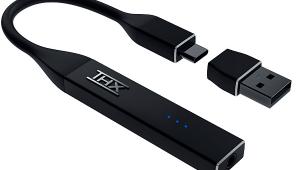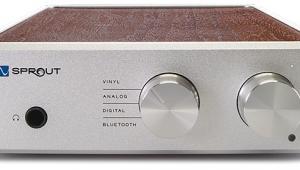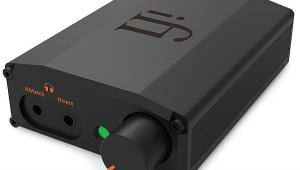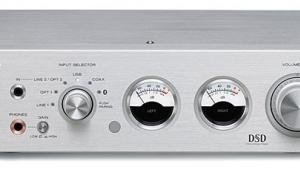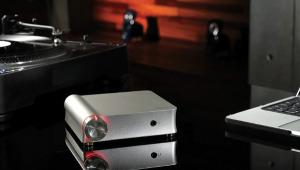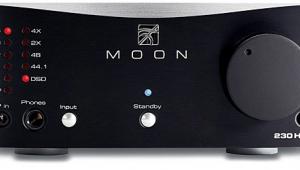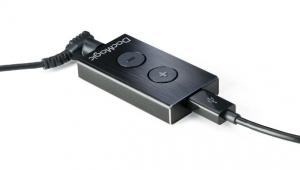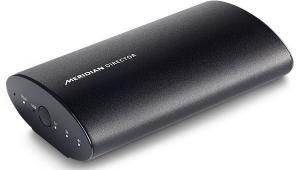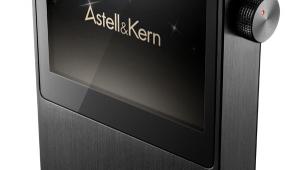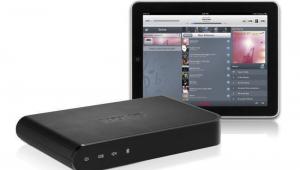Review: DigiZoid ZO2 and FiiO "Rocky" E02i Headphone Amplifiers Page 4
DigiZoid ZO2
This recent update of DigiZoid's peculiar little glowing bass-boosting headphone amp (or "personal subwoofer" as they put it) shares the aesthetic details of its ancestor - which is to say that you'll find it's ultra minimal user interface either pleasantly stylish or the most infuriating thing you've used in recent memory. My feelings are mixed. Like alien artifacts? You'll love this.
It does sound quite nice - which is a good thing since the mystery lamp volume and tone controls make it pretty much impossible to achieve a neutral setting; nor is there a bypass switch for reference (this, to me, seems necessary in such a device, and would save you from having to unplug in the case of a dead battery - a very useful convenience feature).
If the Rocky's limited choice of bass boost settings ("on" or "off") isn't granular enough for you, you might like the ZO2 a lot - you've got a tone control that gives you 32 steps of adjustment. These are labeled, mysteriously, only by color, from green (tilted toward the treble) to red (maximum bass boost). It really felt to me more like the kind of "loudness" or "contour" control you might have had on your 80s receiver; giving you the sense of your speakers playing a bit closer to full-out even when throttled so as not to annoy your neighbors
You've got your choice of two volume control modes - you can either use your device's volume control, or the DigiZoid's own (controlled by the same rotary controller that operates the tone signature control; a short press switches functions). Basically, you can set the thing for fixed or variable output. I found that the DigiZoid volume control actually didn't have enough downward range - dependent on program material and EQ setting, I occasionally just couldn't get it quiet enough with sensitive headphones (by the way, the DigiZoid had no problem driving either of the planar magnetics to reasonable levels, whatever the setting).
But UI quibbles aside, I generally preferred to maintain control of the 'Zoids's output volume. And for this reason, I would really have liked to see a second knob on this thing, removing the need to click to switch between volume and tone control modes. Maybe even a physical high/low gain switch. The enclosure is big enough to accommodate it, and it'd just make setup and listening a whole lot easier, if not as cool looking. EQ curves and levels are interactive, and having to switch back and forth as you're zeroing in on a preferred setting is distracting. But this is a matter of taste, in some ways, and once you get used to using the controls, it's not that difficult to keep track - though you do need to be careful of your ears if you're in the variable volume mode.
DigiZoid suggests using the ZO2 as a "personal subwoofer," in line with your mobile device to drive a small speaker, so I hooked it up to the FoxL v2, which is a bit lacking in the low end but sterling everyplace else in the frequency spectrum. The ZO2 definitely bought me some more output, at the price of perceptible distortion (and the poor little thing's passive radiator was excursing like mad - have your rubber mat handy). This was really much better experienced at low volume, reinforcing my feeling that the ZO2 functions best when used as an old-school loudness control. So if you want a little more oomph in your low-volume listening, this might be worth investigating.
At louder volumes, turning up the EQ much beyond yellow-green wasn't really possible with vocals - more bass, but just too much evident strain with our old standby, Holly Cole's reading of Tom Waits' "Train Song" and with Roxy Music's "To Turn You On" - but with electronic music (the above mentioned Autechre and Photek tracks), it did get me a more idiomatic and fairly acceptable sound.
Is it technically a "better" sound? Maybe so, if your concern is euphony, maybe not at all if you're interested in what they used to call "fidelity" - but on its own terms, this thing succeeds admirably, providing a huge range of adjustment and quite good sound quality in a tiny, affordable package that'll defintely open up your portable listening options, whether you're using headphones or small speakers.
